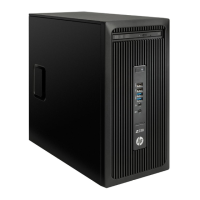
Do you have a question about the HP Z238 and is the answer not in the manual?
| Processor | Intel Core i5 or Intel Core i7 |
|---|---|
| RAM | Up to 64GB DDR4-2400 |
| Storage | 500GB-2TB HDD |
| Graphics | Integrated Intel HD Graphics or optional discrete graphics cards |
| Operating System | Windows 10 Pro |
| Expansion Slots | 1 PCIe x16, 1 PCIe x1 |
| Ports Front | 2 USB 3.0, 1 Headphone/Microphone Combo |
| Ports Rear | 4 USB 3.0, 2 USB 2.0, 1 DisplayPort, 1 VGA, 1 RJ-45 |
| Power Supply | 180 W |
| Networking | Intel I219-LM Gigabit Ethernet |
| Optical Drive | Optional DVD-ROM or DVD-RW |
Details on technical specifications, regulatory notices, and system board.
Information on how to get support and warranty details.
Where to find user guides, white papers, and videos.
Tools and methods for diagnosing hardware issues.
How to find and install the latest BIOS and drivers.
Describes the physical components of the workstation.
Identifies components on the front of the workstation.
Identifies connectors and ports on the rear of the workstation.
Details weights, dimensions, and environmental specifications.
Guidelines for maintaining adequate airflow around the workstation.
Step-by-step instructions for connecting components and powering on.
Planning and connecting additional monitors.
Information on installing extra hardware like memory or drives.
Details on physical and chassis intrusion security features.
HP's policy and information on recycling electronic hardware.
Initial software activation and OS customization.
The process for the first-time setup of Windows 10.
How to adjust display settings like resolution and refresh rate.
Proper procedures for shutting down the operating system.
Lists other available documentation and resources.
General advice and troubleshooting steps.
Initial steps for diagnosing system problems.
Understanding system error codes from lights and sounds.
Overview of HP's software for system maintenance and support.
How to use HP's tools to diagnose hardware issues.
Steps to create a bootable USB for diagnostics.
What to do and prepare before contacting support.
Procedures for creating backups and system recovery.
Initial installation and configuration of Windows 7.
Importance and process of installing device drivers.
Using Windows tools for data migration.
Tools and methods for data protection and system recovery.
How to back up personal files and settings.
Using restore points to revert system changes.
Procedures for full system recovery and data erasure.
Recovering the system using a built-in partition.
Steps for recovery using provided DVDs.
Information about systems preloaded with a minimal OS for Linux install.
How to obtain and use driver discs for Linux OSes.
Guide for installing and configuring Red Hat Enterprise Linux.
Using HP driver discs during RHEL installation.
Information on supported SUSE Linux versions.
Using HP driver discs during SLED installation.
Information on supported Ubuntu versions.
Steps for setting up Ubuntu preinstalled on the workstation.
How to use HP driver discs with Ubuntu.
Methods for restoring preloaded Ubuntu systems.
Creating media for Ubuntu system restoration.
Using F11 for Ubuntu restoration process.
Alternative method for initiating Ubuntu restoration.
Information on HP-supported proprietary graphics drivers.
General guidelines for keeping the system up-to-date.
How to check and update the system's BIOS.
Steps to find the current BIOS version.
Procedures for downloading and installing the latest BIOS.
How to update drivers for peripheral devices.
What information to prepare before contacting HP support.
How to find serial numbers and product IDs on the workstation.
Where to find warranty status and Care Pack details.
Online resources and tools for system troubleshooting.
List of HP support websites for troubleshooting.
Accessing HP's portal for troubleshooting tools.
Using HP's chat service for support.
Finding important product change notifications and advisories.
Information on proactive notifications for product changes.
General suggestions for isolating and resolving problems.
Troubleshooting steps for issues occurring at system startup.
Troubleshooting steps for issues during normal operation.
Information on ordering parts for self-repair.
Additional troubleshooting resources and tools.
Safety guidelines for cleaning the workstation.
How to clean the external casing of the workstation.
Instructions for cleaning workstation keyboard keys.
Guidelines for cleaning the workstation's display screen.
How to clean the workstation's mouse.
Information on assistive technologies supported by HP products.
How to contact HP for accessibility questions or feedback.